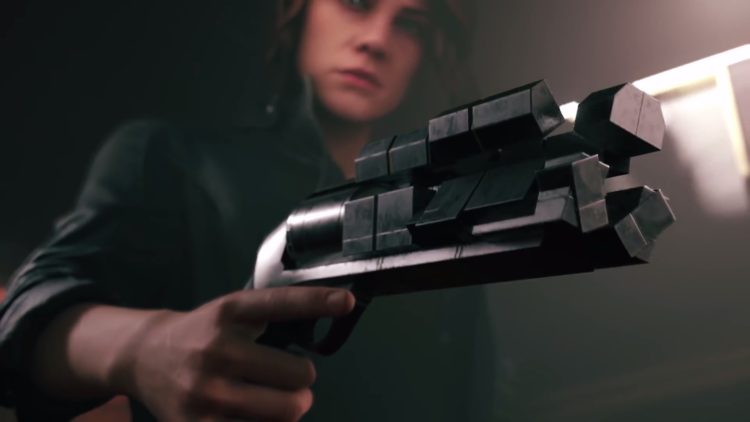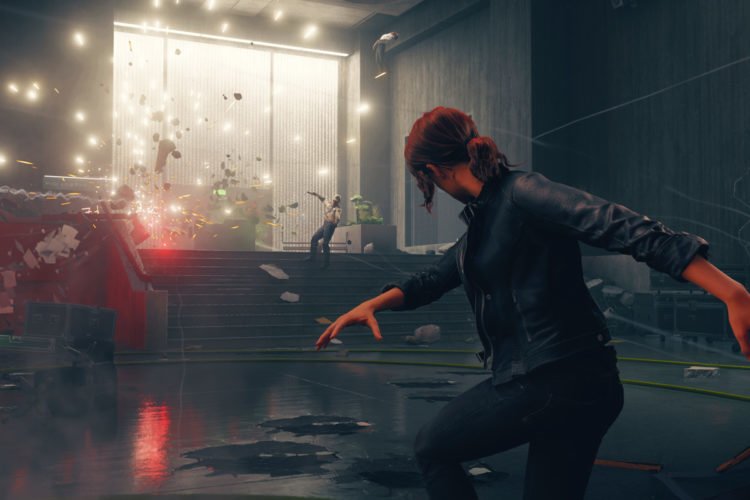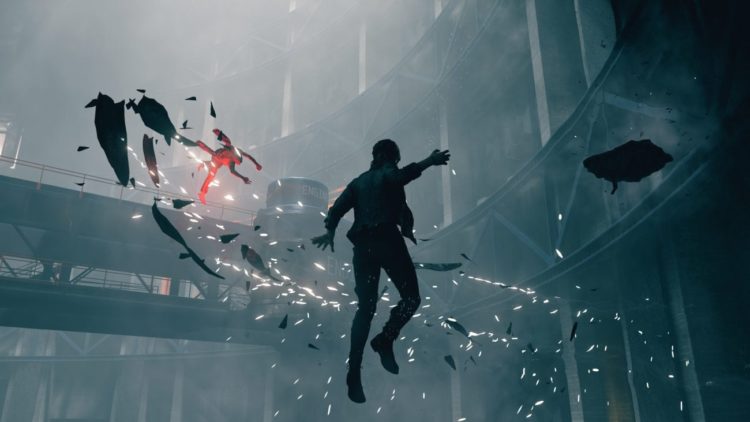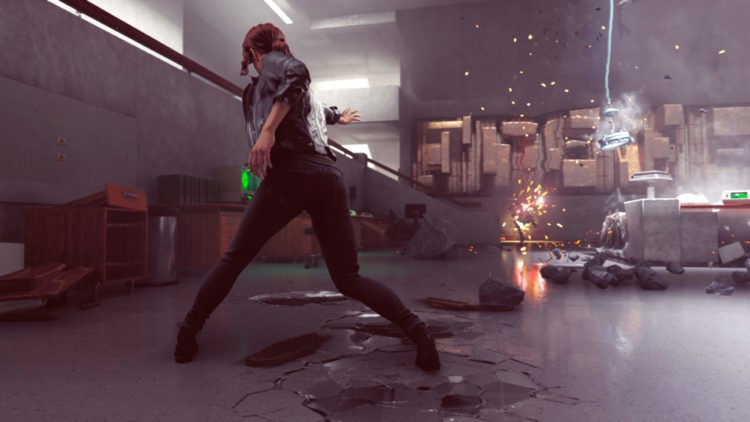
Should you check out the SCP-inspired films of Klay Abele and the recent Remedy game ‘Control’?
Visual effects artist and filmmaker Klay Abele has been working on a series of short films, with actor Jason Posey, inspired by the user-created catalog of paranormal entities known as SCP Foundation (Secure Contain Protect). The first entry titled ‘Site 22,’ which can be viewed here, did not feature a specific SCP entry, but an original creature. The second film, however, will focus on a creature known as “Shy Guy.”
 This particular creature with the designation of ‘SCP-096’ is a hairless, pale, humanoid figure with elongated arms and is typically in a docile state. Shy Guy’s face is always covered by his hands, not allowing others to see his visage. If, however, a person does get a look at the beings face, their fate is sealed. 096 will enter into an enraged state and attack the offender, regardless of where they’ve fled to. What makes this character even more terrifying is that you don’t even need to view his face while in Shy Guy’s vicinity. Observing a photo or video of his mug can land someone on the chopping block. Perhaps 096 is just really upset that he can never use Instagram?
This particular creature with the designation of ‘SCP-096’ is a hairless, pale, humanoid figure with elongated arms and is typically in a docile state. Shy Guy’s face is always covered by his hands, not allowing others to see his visage. If, however, a person does get a look at the beings face, their fate is sealed. 096 will enter into an enraged state and attack the offender, regardless of where they’ve fled to. What makes this character even more terrifying is that you don’t even need to view his face while in Shy Guy’s vicinity. Observing a photo or video of his mug can land someone on the chopping block. Perhaps 096 is just really upset that he can never use Instagram?
Klay Abele’s ‘096’ short film is currently in production with a few scenes still yet to shoot, and a lot of post-production. He has been streaming parts of the character animation process on YouTube. We had a chance to speak with Mr. Abele about this upcoming short and how he intends to bring the creature to life on screen. Check it out:

In the mood for something more interactive? Let’s take a look at Remedy’s newest horror-themed game for the PC, XBOX, and PS4. While it does not directly mention SCP by name, the studio behind ‘Max Payne’ and ‘Alan Wake’ took a stab at the foundation’s idea of a library of haunted objects with their own game titled ‘Control‘. Remedy continued to go down the paranormal route they laid out with ‘Alan Wake’ and it pays off to a certain point, with a few pitfalls along the way.
‘Control’ puts you in the shoes of a woman named Jesse, who finds herself becoming the new director of the Federal Bureau of Control, a shady organization that has been holding her estranged brother captive for some time. A recent event has led to many of the security personnel in the facility to become possessed, leaving only a skeleton crew intact to figure out how to end the calamity before it spreads outside of the building.
The FBC’s purpose is to find, contain, and study seemingly mundane objects that secretly contain reality-altering powers. You know, time-traveling toasters and murderous 1950’s refrigerators. Sadly there is no magically refilling pumpkin latte cup. Oh, the price some would pay for that this coming Fall season. In short, there’s a lot of lore in the game’s story, but sadly it is given to the player in the form of documents rather than gameplay.
Reading the various research papers is entirely optional. Some puzzles and bosses have their secrets spoiled in these documents, but the overall gameplay style is forgiving enough that some light experimentation is all that’s really required to keep progressing through the main campaign. The bulk the fun of ‘Control’ comes in two forms: “guns” and throwing stuff like a more stable version of Jean Grey.

Remedy did try to subvert expectations when it came to the gunplay by making the weapons “constructs” rather than the typical live ammo firing fare. Rather than a nice shiny Magnum, the player gets a twitchy shape-shifting mass of black LEGOs. Regardless, the constructs are just different versions of the standard sidearms and long guns. Jesse starts out with a pistol that deals moderate amounts of damage, the catch here is that the ammo gradually refills between discharge sessions … slowly.
As the player levels up Jesse, she gains the ability to build more constructs that act as higher-powered firearms such as a shotgun, rifle, grenade launcher, and a few others. Each weapon can be upgraded to unlock up to three accessory slots. Strewn throughout the game various enemies and chests gift you powerups that can be used for both the weapons and Jesse. These run the gamut of additional health, increased damage, recharge speed and so on. Some are far more useful than others and Jesse can only carry so many of these at once. So, the player will be discarding many of these as part of inventory management. Luckily discarded items are turned into the currency needed as part of the crafting system.
Crafting can easily be overlooked in this game, due to the frequency in which perk items are dropped by enemies and/or found. Randomized slot upgrades can be manufactured in the crafting system, but typically you’ll be hoarding the resources to purchase overall upgrades to the guns or to create whole new weapons. Depending on the playstyle of the player, it is entirely possible to go through the game with the core three weapons received early on.

The secondary means of attack as mentioned earlier is the ability to hurl objects at enemies with a convenient auto-targeting system. By leveling up the player, something that comes not after a certain number of kills, but from the completion of objectives, Jesse can increase her ability’s effectiveness. Eventually, skills become unlocked that allows her to throw back projectiles and even the larger enemy types can be chucked across the screen once their health is depleted.
By searching outside quests, usually unlocked via conversations with NPCs, Jesse can become quite the powerhouse. The additional powers include levitation, mind control, and a limited shield. Taking the time to seek out these quests truly impacts how easily one can deal with bosses or the higher level soldiers.

It’s not all non-stop action in ‘Control’. A great deal of time is spent traversing the FBC facility. The environments in ‘Control’ are decidedly bland. The FBC building is full of gray corridors, occasionally opening up to brighter atriums or dark quarries. This place certainly looks like a government office. It’s all business and few frills. Unfortunately, the lack of a good map leaves navigating the floorplans a bit of a pain. Rather than allowing the player to freely search the map by level, Remedy decided to make the map only visible during gameplay as an overlay across the entire screen and is locked into whatever sector/floor the player is currently on. While this is useful when trying to figure out exactly where you’re running to, not knowing if you need to head up or down multiple levels to reach an objective is a nuisance.
Luckily the checkpoints sprinkled in each sector allow you to fast travel via a map system that really should have been available in a pause menu from the beginning. The fast travel system will highlight what general area your objective is in, but it’s up to the player to find the exact location as there are no waypoints on the heads-up display.
Outside of directly engaging with the enemy, which the player will do often since enemies and enemy types randomly respawn in most of the larger rooms, there’s not much to do if the player strays from the main missions. Some NPCs will give you errands to run that act as side missions and exploration will yield hidden areas with chests. Occasionally the player can find projectors or televisions that provide exposition via live-action video. The reward for checking each random office or out of place nook isn’t always worth the time. The meat of the game, however, is strictly in following the storyline. That story isn’t exactly as enthralling as Remedy’s previous games, though.
The true negatives of the experience come from the characters and some performance issues. Jesse as a character is uninteresting. Her motivation to find her brother is defined early on, but it is her reactions to all the strange stuff going on that is lacking. Some of the bigger events may be met with an expletive, but Jesse always feels like she’s just going with the flow as if there are no consequences to failure. During dialog scenes where some emotion is called for, the facial animations of most of the characters are set to deadpan. While not ‘Mass Effect: Andromeda‘ levels of bad, it is still distracting. A fridge just blew a man up? Stare blankly at the person who just relayed this info to you. Finally found your long lost brother? Stare blankly at him as he levitates in a cell and spouts gibberish. Yes, it as emotionally gripping as ‘Twilight‘.

The lack of emotional involvement from the cast crippled how much one can be engaged with the plot, but the gameplay cycle overall is just fun enough to chug ahead just to see what new set piece or creepy creature is just down that next corridor. That is until the game’s performance dips, which is quite often on the XBOX. The glorious particle effects that spring up in every battle can and will cause the framerate to drop a considerable amount, leading to cheap deaths. Some boss battles hinge on the player being able to swiftly navigate multiple levels or platforms, but if the game stutters along it is easy to not notice a huge hole that just opened up in the floor leading to a bottomless pit, or for an exploding enemy to get to close because the jerky framerate caused you to greatly misjudge your aim.
These issues aren’t solely relegated to too much going on in the heat of battle. Bringing up the map also results in the framerate being divided in half. The select screen, too, somehow bogs down the performance, leaving the player stuck in a single-digit framerate limbo when exiting the menu. That’s a real pain when you’re swapping out equipment during a fight with a heavily armored grenade shooting baddie.
‘Control’ is nowhere near the character-heavy ‘Max Payne’ or ‘Alan Wake’ games as far as strong leads and engaging narratives go, but at the same time, it doesn’t fall into the trap of using generic jumpscares or copy-and-paste creepy visuals that are prevalent in many games that also attempt to adapt SCP creations. If the performance bugs can be ironed out with future passes Remedy fans should certainly pick this up as it pays homage to the company’s previous titles, but newcomers may be better off waiting until this one dips in price.
